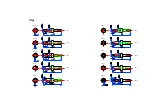
5.
If the temperature still has deflection, you can repeat calibration in accordance with above
steps.
* We recommend using the 191/192 thermometer for measuring the tip temperature.
* If the unit is locked by password, it will not be able to calibrate and you must input the right password.
Tip Care and Use
․
Tip Temperature
․
Cleaning
․
When not in use
․
After use
High soldering temperatures can degrade the tip.
Use the lowest possible soldering temperature. The
excellent thermal recovery characteristics ensure
efficient and effective soldering event at low
temperatures. This also protects the soldered items
from thermal damage.
Clean the tip regularly with a cleaning sponge, as
oxides and carbides from the solder and flux can
form impurities on the tip. These impurities can
result in
defective joints or reduce the t
ip's
heat conductivity.
When using the soldering iron continuously, be sure
to loosen the tip and remove all oxides at least once
a week. This helps prevent seizure and reduction of
the tip temperature.
Never leave the soldering iron sitting at high
temperature for long periods of time, as the tip's
solder plating will become covered with oxide,
which can greatly reduce the tip's heat conductivity.
Wipe the tip and coat the tip with fresh solder.
This helps to prevent tip oxidatio
Maintenance
Inspect and Clean the Tip
1.
Set the temperature to 250
℃
.
2.
When the temperature stabilizes, clean the tip with the
cleaning sponge and check the condition of the tip.



























